
|
|
|
Search our site
Check these out    Do you have an entertaining or useful blog or personal website? If you'd like to see it listed here, send the URL to leon@pawneerock.org. AnnouncementsGive us your Pawnee Rock news, and we'll spread the word. |
Too Long in the WindWarning: The following contains opinions and ideas. Some memories may be accurate. -- Leon Unruh. Send comments to Leon March 2008Lift the chorus ever onward
Those fans may not have disliked the Jayhawks, but they loved the idea that the opposing squad of overachievers dressed in devil's red might go to the Final Four. Davidson represented the hope of mankind against the giants, and all that. Everybody prayed for victory. As we know, only KU's prayers were answered with a smiley face. Three seasons of what we Kansans consider failure were on the verge of becoming four when suddenly the Jayhawks, who didn't play especially well Sunday, were no longer the team buried in a snowdrift at the end of winter. The opponent's last long shot missed because of good KU defense, and Kansas won by two points. It was a hard game to the end, which was good for CBS TV but impossible for me to watch without saying a bad word here and there. To everyone's relief, there was no drawn-out parade of free throws, no time for schmaltz from the TV announcers, no moist shots of the eventual winners congratulating themselves before the buzzer. Finally, April is at hand and there is nothing the matter with Kansas. Or with Bill Self; it's OK with me if he keeps his coaching job for another year. As a reward for reaching the Final Four, KU gets to play Roy Williams and North Carolina, a team with its own mythology. Maybe you've heard the old question: Why's the sky Carolina blue? Because God's a Tar Heel fan. We'll see about that. Metrecal, a drugstore treat[March 31] Ray Randolph, writing Sunday from Indianapolis, remembered Metrecal: "Your mention of Metrecal took me back to my working days at Cheyenne Drugstore in Hoisington during high school. The owner had the Metrecal displayed in a prominent place. I don't recall how much people bought but I'm sure a few took advantage of the new product. "Good luck on your break from Diet Coke. I could never get used to the after taste of diet drinks, no matter the brand or flavor. And I'm with you on iced tea, which along with spring water and milk are my drinks of choice. "... A roast beef sandwich in one hand, a cookie in the other, and a drink between my feet...." Classic stuff, this!" Thanks for your kind words, Ray. I'm glad someone else remembers the stuff too. Goodbye, Diet Coke[March 30] On February 18, I looked into my plastic bottle of Diet Coke at breakfast and wondered where the magic had gone. I drank the last two ounces and let them sit in my mouth for a moment, and at that point I decided I was through with Diet Coke. I brought my four remaining bottles in from the garage and with a bit of pomp announced to my wife and the boys that I was herewith giving up Diet Coke. I had each of them help me by pouring one of the bottles down the kitchen drain, although Nik was keen to shake his up and spray it all over the front yard. The "diet" part of Diet Coke never was much of an attraction to me; instead, I craved the battery-acid flavor and caffeine. Maybe I was addicted. Still, I had come to wonder whether the aspartame and who knows what other ingredient was messing with my metabolism and organs, and I was a little ashamed of the cost and how the unrecycled bottles filled my trash can. So the right thing to do was simply stop drinking it. I did that once before, in 1995 or so, and my friends then asked whether stopping cold turkey gave me headaches. Not that time, and not this time.
Tab didn't do anything for me; it ranked even lower than milk. Bubble-Up and Pepsi and iced tea tasted much better. Another drink that showed up in our refrigerator was Metrecal. (Watch an early Metrecal TV commercial.) The Metrecal company is said to have produced the original diet health drink, which I've seen called both the "first Slim-Fast" and "Red Bull for the 1960s," and cookies, which apparently had some low-cal properties. The best thing about the chocolate drinks was that we used a church key to open them, and a boy my age could sit around all day opening cans that way. More than that, however, I liked the cookies, especially Lemon Crisps. Boys aren't interested in nutrition claims, which were the cookies' main bragging point. In the 1960s, when food laws were weaker, "low calorie" may not have been required to actually mean "low calorie." I remember the boast: "9 Metrecal cookies make a complete low-calorie lunch every bit as nourishing as Metrecal liquid." I'm sure it was every bit as nourishing.
Two or three times a year, Mom would load Cheryl and me into our blue Dodge Coronet 440 and drive us to northwestern Arkansas, where her parents and brother lived. It was an eight-hour drive from Pawnee Rock, and she didn't want to stop much along the way. Would you, with two brats? A night or two before we left, Mom would cook a roast and then make sandwiches. She froze the sandwiches, which thawed as we drove south on the new Interstate 35 toward Perry, Oklahoma, and then east through Tulsa and Kansas into Arkansas. I tell you, there's nothing better for a 12-year-old than being driven down the highway, a very cold roast beef sandwich in one hand, a Lemon Crisp in the other, and a cold drink propped between his feet. But all that's in the past, piled in the dustbin with the Diet Coke bottles. Now I'm back to the basic drink, the one I grew up on, the nectar of the gods -- iced tea. No sugar, just lemon, and strong enough to walk home alone. A photo I like: No. 80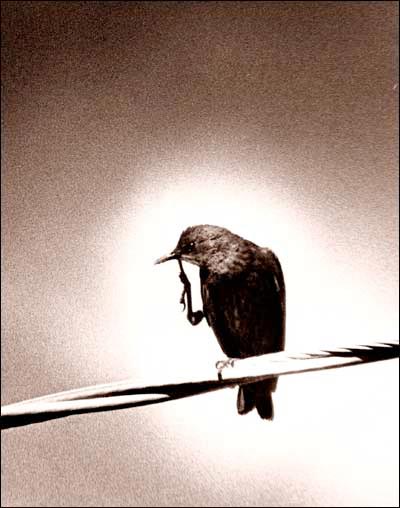
[March 29] I don't know whether birds can be embarrassed, but this one didn't mind if I took its picture while it attended to nasal cleanliness on a spring day in Larned. I suppose birds do this all the time, but it was the first time I had ever seen such a thing. (I wish people in their cars didn't feel the same freedom.) The grain of my Tri-X film is clearly evident, and so is my small-town journalistic technique of clumsily burning in the print to make the sky darker. I don't see that much in photography now that there are so few black-and-white photos being made. Digital photography allows a lot more subtlety. Husband of the mayor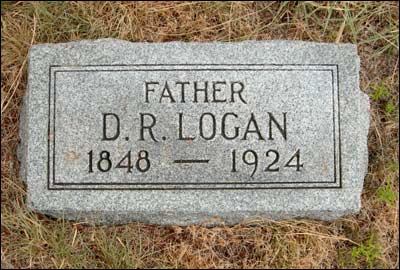
[March 28] One of our prominent shopkeepers was D.R. Logan, who arrived when Pawnee Rock was founded in 1872. In addition to his general store and furniture store, Logan was the vice president of the Farmers and Merchants Bank, which existed in the building that now houses the post office (that's the old bank vault inside). He was also the postmaster for 20 months in 1875 and 1876, with the post office probably in his general store on the west side of Centre Street. The Logan family plot is easy to find in the center section of the Pawnee Rock Cemetery. The Logan children had it rough; at least four died. It's likely that their coffins were made in the family furniture store, which in those days often performed that business as well. A remarkable point in Logan's biography is the sentence stating that his wife, Maggie, had been Pawnee Rock's mayor. I don't know yet when she was the mayor, but Kansas made itself famous in 1887 when the residents of Argonia, in Sumner County, elected the nation's first female mayor, Susanna Madora Salter. Mr. Salter and Mr. Logan were both shopkeepers, so their wives likely worked in the stores and would have been well known and trusted in town. I want to know more about Maggie Logan's term, but the 1912 book this was taken from, the "Biographical History of Barton County, Kansas," has very few details about the women who settled our part of the state. D.R. Logan died in 1924, and Maggie Logan died in the 1930s (I think). Dennis Rudolph LoganDennis Rudolph Logan was born August 22, 1848, in Huntington County, Pa. He came to Barton County in 1872 and located a homestead near Pawnee Rock. it being the southeast quarter of 32-15-20. He proved up on this claim, residing there four years. Then he went to Barber County where he was in the cattle business for two years. At the end of this time he returned to Pawnee Rock and formed a partnership with Chas. Gano. This partnership continued for several years when Mr. Gano sold out to E. W. Smith. The firm of Logan & Smith continued for several years in the same business after which Mr. Logan became the sole owner of the store which carried a fine line of general merchandise. Mr. Logan has been engaged in mercantile trade in the town of Pawnee Rock for thirty-five years and at the present time owns a big general store and a completely stocked furniture store both of which are under his personal management. Mr. Logan was married to Maggie T. Mardis of Johnson County, Kansas, July 25, 1847. They are the parents of six children: Earl, 29, assists his father in the management of his business interests; Helen, 15 years of age, resides at home and is being educated in the schools of the county; Arthur, 17; Lloyd, six months, Effie, three years and Roy, two years, died at the ages given. The cause of their deaths being an affection of the throat which was so common among the children of this section in the 80's. Mr. Logan has always taken an active part in the upbuilding of Pawnee Rock and the development of this section of the county. In addition to his business interests, Mr. Logan owns a fine modern residence containing nine rooms, bath, closets, etc. Several town lots and 60 acres of farming land which is being cultivated by renters. He is vice-president and a director of the Farmers and Merchants Bank and owns both the business houses which are occupied by his stores. Mr. Logan is one of those pioneers who came to this county at a time when it required nerve and great faith in the future to remain here and withstand the hardships incident to home building and development work at that time in the State of Kansas. Mrs. Logan enjoys the distinction of having been mayor of Pawnee Rock. She is one of the few women in the State of Kansas who has held the highest office in a municipality. The Logan family is one of the best known in Barton County and Mr. Logan is especially well known in commercial circles and has done a great deal to make Barton County one of the best in the State of Kansas. 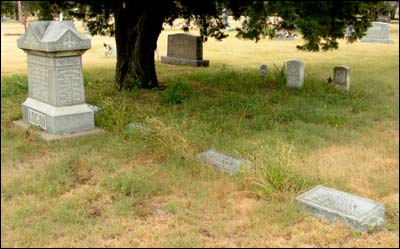
Why we remember the Pawnees
A postcard photo of Pawnee Rock in 1876 shows what the southeast face looked like before it was quarried. This may be close to the view seen by Santa Fe Trail traders and the Pawnees in the early and mid-1800s. This image is from Larry Smith's collection. [March 27] We've all heard the story about how Kit Carson shot his own mule and in doing so created the legend that led to the naming of our Rock after the Pawnees. There were many skirmishes between Santa Fe Trail travelers and the people who occupied these lands at the time. Here are a couple of anecdotes from the wonderful book compiled by Shiela Sutton Schmidt, "Pawnee Rock: A Brief History of the Rock." AN INCIDENT AT PAWNEE ROCKDuring the early 1800s, trappers and traders made their way past The Rock by means of pack-horses or pack-mules. Once seven Americans were surprised by a band of Pawnees. For two days the Americans stayed on The Rock without water, and with only a small quantity of provisions. Finally they were rescued by a large party of traders coming down the Santa Fe Trail. HOW PAWNEE ROCK GOT ITS NAMEPawnee Indian Territory was in what is now Nebraska. From there the Pawnee Indians followed a route to the south past The Rock to what is now Oklahoma on hunting expeditions. One time, at the Rock, a small band of Pawnees was attacked by a large band of Comanches. (Some versions say it was a band of Cheyennes. Other just say bands of Indians.) The Pawnees took refuge in the crevices of The Rock. The siege lasted for days. The Pawnees, crazed by thirst, killed their ponies one by one and drank the blood. Finally, in desperation, they tried to run to the creek. Every one of the Pawnees was killed by the Comanches. The Comanches admired the courage of the Pawnees, and erected a cairn on top of The Rock in their honor. From then on, The Rock was known as Pawnee Rock. [Leon's addition: The creek mentioned in the second story could be Ash Creek, which straggles along just west and south of where the town of Pawnee Rock is. It's about a mile from the Rock at its closest point. A smaller waterway (when there's water) runs south in the draw the starts between the cemetery and the old salt plant; it passes close to the Rock on the west side and empties into what is now the ditch on the northern city boundary.] A family tree
[March 26] At the southeastern corner of my grandparents' chicken house stands an elm that has been there for as long as I have known the farm. I don't think I ever used the tree for shade (who wants to dawdle where chickens poop?), but I walked past it hundreds of times to feed the chickens or to collect the eggs or just to wander down into the draw. The tree's trunk is shaped in a way that made climbing up a few feet easy for even an awkward boy. Age has amplified the bend so much that the trunk now looks like a grandpa's lap. My dad, Elgie, knew this tree; he grew up on the farm. Perhaps he planted the tree seventy or so years ago to give the chicken house protection against the sun and wind. But if the tree was planted instead when the farm was raised by his grandparents in 1906, a 10-year-old Elgie in 1936 might have been able to climb the tree just as I did.
What does Dad remember of this tree? Well, his memory for many things isn't too strong lately, and he might not consider them fit to mention anyway, because some moments are too treasured or fleeting and he has always been private. Nevertheless, I like to think that little things -- when he sees an elm sway in the Great Bend wind or when Betty fixes him chicken for lunch -- bring to his mind a flash of boyhood exuberance. Our family now is gone from the farm, and cattle graze in the yard. When I touch this venerable elm, however, I remember spring days when the place was full of people: my sister, my parents, my cousins, my aunts and uncles, my grandparents. And it's easy to imagine the farm a generation earlier, the chickens scratching the dirt, the kids shouting, and my dad laughing and working like spring would last forever. The Spreier family history[March 25] One family name long entwined with the history of Pawnee Rock is Spreier. You probably know a bunch of them if you've lived long in town. A scion of the family, Jared Smith, whose mother is the former Joan Spreier, found a big chunk of Spreier family history in the digitized version of "A Standard History of Kansas and Kansans," published in 1919. You can read about Jacob Spreier and his industrious son George, who arrived in 1875. George worked on the railroad at first, to help the family make ends meet, and farmed as an adult. Two of George's brothers worked on the railroad locally with Michael Sweeney and farmed.
Oldtimers will know of George and Mary Spreier's offspring: Christina, Frank, Paul, Amy, Anna, Victor, Chester, Donald, and Noel. Paul, who owned the house that became the Mennonite parsonage in 1949, is the grandfather of Jared and his brother Larry Smith, who sends us many photos. 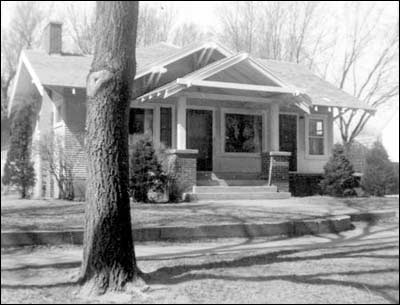
The former Paul Spreier home That rascally Bunny[March 24] Our young sons are like most adults -- they're willing to believe in the irrational as long as they get candy and gifts. As it is with Santa Claus, so it is with the Easter Bunny. Now, back in Pawnee Rock you and I probably still welcomed the Bunny to our yards long after we stopped talking to our friends about it. I assume that means not only that we really didn't believe in the Bunny, but also that we really didn't not believe. Our parents no doubt were willing to oversee the dyeing of the hen fruit and the early morning hiding of them under the tulips just because they wanted to keep thinking of us as young and innocent. I don't want my sons to grow up too fast, either. And so when Sam and Nik went through their annual pooh-poohing of the Bunny story, followed by the creation of outlandish plans to capture the Bunny in the act, I went along. This year's Bunny trap took a practical approach: packing tape strung between a chair and a wall, a broom laid as a barrier between a chair and the other wall, and a digital point-and-shoot camera set up to take movies. (The boys didn't feel like going out in the snow to look for eggs this year -- been there, done that, and it's not as much fun as it sounds -- so they left their baskets on the kitchen counter.) Playing a practical joke on the Bunny, the boys left a bowl filled with water, curry powder, hot sauce, and some ingredient that made the whole mess green. Before bedtime, they were beside themselves with glee imagining the poor Bunny tasting the glop. I know this is the boys' attempt at solving a mystery they don't want solved. You probably did the same thing, setting elaborate traps with clothespins and string and drawing diagrams that had the Bunny following a plan you laid out. (OK -- maybe you didn't do exactly this, but I bet you dug a hole in the backyard and covered it with sticks and leaves to catch rabbits that might come through the forsythias. You didn't really expect to catch a rabbit, but you wanted to believe that your trap could do the job.) The Bunny did show up on Easter morning. This is what we know from the evidence the boys discovered shortly after dawn:
Sam and I went for a walk later on Sunday morning, searching for hare tracks in the snow. We found some, bending down to look at how the rear feet overlapped the front set as the little critter hopped through the woods. It had been a week since the hare had scampered there, but the age of the tracks wasn't important. What mattered was that the Bunny could plausibly exist for another year. An elegy: Our friend Peg Britton, who last week lost her grown son Dane, has written a beautiful piece about what time means to us all. Kansas' scenic highways[March 23] Leon Miller, a Pawnee Rock native who lives in Dallas, makes occasional trips north. Kansas is a nice place for driving, but there are some hazards: "When my wife and I travel north to visit my sister in Hays, we always go up IH 35 to Wichita, then IH 135 to Salina and then IH 70 west to Hays. However, when we come back we prefer to take US 183 south through Liebenthal, Lacrosse, Rush Center, Kinsley and on down the back roads into Oklahoma, where we can see much more scenery and get a taste of what our country roots are all about. "The only bad thing about this is last Memorial Day weekend my wife was driving south from Coldwater as I was sleeping. It was the middle of the afternoon and all of a sudden she woke me up with an expletive and started slowing down rather rapidly. Yep, you guessed it; the KHP had tagged her going much over the speed limit. Ironically, she started making all sorts of excuses about why the highway patrol was out on a desolate highway when they should be up on the Interstate. "But I still prefer to see the prettier part of the state, which is off the interstate."
Ray Randolph, writing from the hotbed of basketball known as Indiana, says: "Two down and some to go! "Rock Chalk, Jayhawk A photo I like: No. 79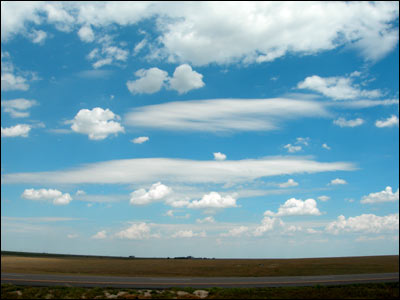
[March 22] I've seen the sky in 36 states and two other countries, and nowhere else is it as grand and entertaining as over western Kansas. I made this photo as I drove Interstate 70 from Denver to Pawnee Rock one August day. Had I the time, I would have found a back road, sat myself on the dirt in the shade of the truck, and watched the clouds saunter by. It's one thing to see them when I'm moving at 70 mph; it's an altogether better idea to watch them move at their own speed. The kings of basketball[March 21] Our Jayhawks and the Wildcats are each 1-0 in the NCAA men's basketball tournament. Ain't it grand? Yes, it is. I'm sure it has been remembered elsewhere already, but I would like to point out that the last time KU won it all, in 1988, the path to the championship went through K-State and two other teams (Duke and Oklahoma) that had beaten the Hawks that season. Saturday, Kansans can Eat 'em up and Rock Chalk all day long. Goodbye, Wisconsin, and toodle-oo, UNLV. Ness City in the news: A town can be a perfectly normal place -- as normal as a town can be in western Kansas -- and all of a sudden it's known for only one thing. I am thinking, of course, of poor Ness City. Perform a Google search for "ness city" or "ness city toilet" and you'll get pages upon pages of stories about "woman on toilet for two years." It's not just Kansas newspapers, blogs, and radio and TV stations that love the story; it's also the Los Angeles Times, CBS News, USA Today, the Orlando Sentinel, the Detroit Free Press, and even KATU TV in Portland, Ore. The boyfriend who lived with the woman, Kory McFarren, has been charged with mistreatment of a dependent adult. Great Bend hangar comes down[March 20] Those who remember the World War II air base at the Great Bend airport ought to check out this Great Bend Tribune story about the removal of a B-29 hangar. One of these big buildings -- the air base/airport had three, I think -- was the first hangar I was ever in. It's the model against which I compare all others. Welcome to spring
In previous Self seasons, KU's hopes died at the hands of Bucknell, Bradley, and UCLA. Who will ruin it for KU this week -- Portland State or Lon Kruger's UNLV? Nevertheless, in my office pool I have picked Kansas to win the national championship. It's a dream that cost me only five dollars. If KU wins, there's still time to write Self's name in on the presidential ballot. And maybe Michael Beasley and the rest of K-State's Wildcats will do what Danny Manning and the rest of the Jayhawks did 20 years ago -- win the final six games of the year. It could happen. Coal, pollution, and a raw display of power: The New York Times has noticed the fury arising over coal-burning power plants. The story includes several paragraphs about the battle over the Holcomb power plants, pitting many Kansans against Sunflower Electric and its coal supplier.
Take me anywhere, country road[March 19] There are days when work is unpleasant from the moment I check my office e-mail at home in the morning to the moment I turn off my computer at the office. I won't bore you with details; chances are good that you have those days too and that your days are worse than mine. But I'll tell you what I do. I daydream for a second or two of walking on a country road. It's always a road near my grandparents' farm northwest of Pawnee Rock, probably because those roads were the ones I trod in happy days when my brain was young and absorbed everything. The wind pushes on me a little. It's brisk if I'm having a March daydream and faintly oppressive if I'm in a summer idyll. I like the wind, unless it masks the sound of a car behind me on the gravel road. I amuse myself by kicking gravel as I walk, but more often I find dirt clods left by the grader after it grinds down the muddy-season ruts. The clods explode when I kick them and before long my socks (summer) or jeans (winter) are the color of loess. A ringneck pheasant struts onto the road, then sees me and runs twenty feet farther ahead before dipping into the weeds. Maybe a jack rabbit bounds across. Always, there's a meadowlark. Barton County's hill country is a dry place, as parched as a sponge, when I walk. Sometimes my imagination brings forth a storm -- long sheets of rain hanging below a thunderhead -- from the lightning-struck horizon. The wind shifts, and the temperature falls. A humid aroma replaces the scent of the dry and grassy farmland; it's as if "green" has become a smell. There's a quarter-mile of driveway from the mailbox to my grandparents' house. The air is fresher now, and the livestock over at Durward Smith's place are excited by the change and bang the feeders. The dark clouds finally are above me as I pass the locust and cedar shelterbelts and the granaries at the edge of the farmyard. I step up to the wire fence and open the gate under the elm. The air is electric. I start to run up the concrete sidewalk to the covered porch where Grandma sits on the swing, and the rain comes. The workday is washed from my soul. Our friend the author[March 18] Ray Randolph, our former Barton Countian now writing about crime in Indianapolis, is bringing forth "Nothing Lasts Forever." He also has produced these cops-and-robbers books (all are available on Amazon): I've edited dozens of books but have had a hand in writing only one, so I'm fairly envious of Ray's skill and determination to sit and write -- not to mention his ability to come up with plots and dialog. Speaking of writing: A nonprofit newspaper-industry organization, the Poynter Institute, has several bloggers and experts who send out newsletters daily or weekly. One of them, Chip Scanlan, had a piece last week that suggested a handful of writer-origented widgets -- those free electronic doohickeys that you can keep on your screen. My favorite is the word counter, but the countdown timer is fun too. Our friend in Ellsworth: If you've been following Peg Britton's blog on KansasPrairie.net, you know that her son Dane has had a hard three years. Dane's relief has arrived, and Peg has written movingly about it. What to do with Emporia: Emporia has lost 1,500 meatpacking jobs this year, thanks to Tyson's bean-counting whimsy, and now it is trying to figure out how to save itself. Cheryl Unruh, the voice of the Flint Hills, suggests that the city step away from its slaughterhouse reputation and stress higher education. It seems like a good plan for a city with Emporia State University -- make the most of what you have. The restaurant business[March 17] Sunday's item about the short-lived restaurant in Pawnee Rock rang a bell for Leon Miller of Dallas. He owns a little property, including a restaurant building that had one short-term occupant and that now is in search of a renter with a better chance of succeeding. He wrote: "The main reason? They don't have the money to run a restaurant. Like your people at the Pawnee Inn, they think it would be 'a neat deal' to run a restaurant but don't have a clue as to the business end of it. "When my dad bought the old KP Hall back in the '50s, a local townsperson came to him wanting to do run a restaurant. This guy had no business being in there but my dad let him rent the place anyway. I don't know how long he lasted but do know he wasn't around when my dad died in 1967. So relying on a newspaper reporter to give you a positive review on your restaurant does not guarantee the success of the restaurant."
"ROCK CHALK KU-U-U-U-U!!!! Today's game shows who's the best on a 'neutral court.' Maybe KU and Texas will meet again in the finals." The fries are good here[March 16] Mike, a coworker who reviews restaurants for my newspaper, invited Sam and me to lunch with him Saturday at a cafe in town. I had recommended the place for a review, so the least I could do was share the pain or pleasure. He arrived before we did and was filling in a crossword puzzle at the table. We all ordered sandwiches and drinks and, oddly, he started working on the puzzle again. Finally it occurred to me that the folded-over newspaper was his notepad, and he was jotting down clues to his meal among the acrosses and downs. I explained to Sam that Mike kept his anonymity that way. The staff wouldn't catch on that he was a reviewer, and thus he would get the same kind of food and treatment that other customers got. Sometimes waitresses want to help him with the puzzle, he said, which can be trouble when he has written his notes inside the puzzle itself. Within minutes, a waitress peered over his shoulder and started talking about how her husband filled in his puzzle with what looked to her like nonsense letters. That brought to mind my first newspaper story about a restaurant. It was back in 1974 or '75 in Pawnee Rock that a new cafe was about to open its doors on the west side of what had been or would be the Pawnee Inn or Bob's Place. I was a high school senior filing stories for the Larned Tiller and Toiler, so I figured I'd write about the cafe. I don't remember many details about the owners, other than they were a nice couple who appeared to be in their fifties and acted like grandparents. They possessed no restaurant experience, but they had high hopes for the place -- and not a dime to spend on advertising. The cafe was like so many others found along Kansas highways -- a fried-food and iceberg-lettuce-salad menu, paneled walls, and a slight echo inside a building recently used for another purpose. We talked for a while as I took photos and wrote down what the owners said. After 20 minutes, I had an anxious moment when the mister offered me a meal. I wasn't the most educated journalist, but I knew I didn't want to get "bought" by free food. I hemmed and hawed and finally gave in to a basket of fries. The fries were hot, salty, wavy, and crisp. No one else was in the building, so the owners sat and watched me eat. When I wrote a straightforward story describing the couple and their dreams, I said the fries were tasty. A week or so after the story appeared, I got a note from the couple. "Thanks for the nice review," it said. I was angry. I didn't mean my story as a review, and it hurt my feelings to have it understood that way. Over time, however, I came to realize that the owners probably perceived any newspaper story about a restaurant to be a review. In a way, they were right. The mere fact that I wrote about the new cafe was a signal to readers that the cafe met my standards of a decent place. The big thing I learned was the importance of being anonymous when testing a restaurant. As much as I like extra attention for my vast skills and journalistic power, I'd rather avoid the implied purchase that goes with a chef's glad-hand greeting and a waiter's extra-attentive service. Sort of like my friend Mike and his crossword puzzle, I now write my notes on the inside cover of a paperback novel. No one thinks twice about a loner reading in the corner. I'm sad to report that the Pawnee Rock cafe lasted only a few weeks. The fries really were good. A photo I like: No. 78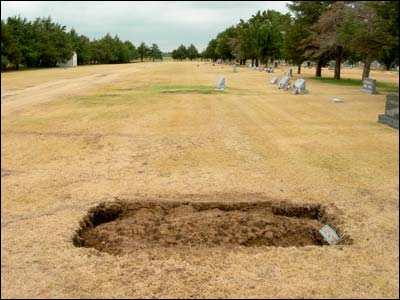
[March 15] This photo shows a grave -- that of Jim Rainbolt -- in the Pawnee Rock cemetery a couple of weeks after his funeral in July 2006 and a day after a big August rain. The grave, sunken after the repacked dirt collapsed, doesn't look good. The sinking, however, is a natural event. When any grave is created and the vault and coffin are laid inside, the dirt that is put back in the hole has much air around it. The rain settles the soil, and the earth embraces the departed. A few days after Mr. Rainbolt's funeral, the sexton brought more dirt and built another small mound, and the next rain settled it as well. Within a year the surface was smooth and grass was starting to spread aross the bare spot. I like the photo because it reminds me of my many hours digging and filling graves at the cemetery and because it helps explain how we, like the earth, heal. 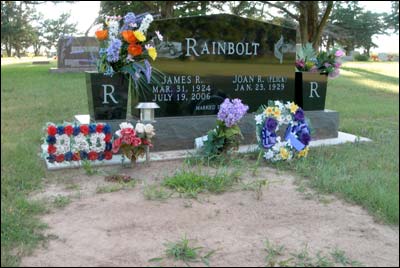
Jim Rainbolt's grave in June 2007. Updating the news[March 14] The sad case of the woman in Ness City deserves decent newspaper coverage, and the Hutch News provides it in a story by Edie Hall.
It'll be interesting in 10 or 20 years to ask Jeff how completing this race influenced his life.
A nightmare at home[March 13] At first it's a joke -- a Ness City woman stayed in the bathroom for two years and eventually just sat on the toilet so long that her skin grew around the seat. Her boyfriend brought her food and drink and eventually called for help, and she was taken to a hospital in Wichita to have the seat cut away. It's so jaw-droppingly ghastly that what can you do but laugh? Heaven knows that today the world is laughing with us. Still, as much as I'd like not to, I put myself in her sweats. I tried to imagine what it would be like to sit there for two springs, two summers, two football seasons, two Thanksgivings and Christmases. To just sit there. Now, I don't know whether there was a TV or a handy stack of Reader's Digests. But after a while, even that wouldn't matter much. What would I think about? What would I no longer miss so much that I wouldn't leave the bathroom for it? The newspaper story mentions beatings as a child. "It just kind of happened one day. She went in and had been in there a little while, the next time it was a little longer. Then she got it in her head she was going to stay -- like it was a safe place for her," her boyfriend told the Associated Press reporter. The world's imagination at creating horror is beyond my willingness to see it all. Frightful things happen behind family doors, in families we know. Sooner or later, retreat may be the best defense a mind can provide, and it would seem perfectly reasonable. It happened in Ness City, a pleasant town where people know their neighbors. It could be happening now in any town just big enough to let a life pass unmissed for two years. We can blame the wind or the heat, or the isolation of living in rural counties, for the stress that families go through. We can blame poverty or incapacity. But what we, in all our towns, can do instead is involve ourselves with our neighbors. Let's keep a better eye out for one another. Let's shape a world in which childhood abuse doesn't make living in a bathroom the best option a Kansan has. Holy Week concert at Bethany[March 12] It's not often that PawneeRock.org gets a legitimate press release, so I wanted to be sure to pass this information after it arrived from Bethany College in Lindsborg. The Bethany College Symphonic Band will present its Holy Week concert on Monday, March 17, at 7:30 p.m. in Presser Hall on the Bethany campus. In that band is Nicolette Unruh, a sophmore from Pawnee Rock. Larned has a couple of players: sophomore Emily Bowen and senior Afton Eye. I'm always entertained by the descriptions written by music directors and publicists, who simply think differently from the way I do. That's probably because they understand the music a whole lot better than I do. I hope you go (go early enough to eat Swedish food downtown). It sounds like a good show, judging by the press release: Selections include Rossini's "Italian in Algiers" Overture, transcribed by Cailliet; "Fusion," a three-movement work by Balmages that draws from various types of pop music and dance forms set within a contemporary framework; "O Magnum Mysterium," a band transcription by Reynolds of Morten Lauridsen's choral setting; "Pathetique," composed in 2006 by Doss, which allows listeners to experience the feelings of true pathos in a stately way; Rimsky-Korsakow's "Dubinushka" or "The Little Oak Stick," written in 1905 and a striking document of a pivotal time in Russia's history; and P.D.Q. Bach's "Grand Serenade for an Awful Lot of Winds and Percussion," a humorous four-movement work "tastefully adapted" by Professor Peter Schickele. Escaping the end of Earth
A sunset is pretty now, but what about in 7 billion years? [March 11] The Reverend Gerhard Peters went around our Sunday school class, asking each one of us youngsters what we most feared about dying. Lots of answers were about heaven and not-heaven. When he came to me, I said I was afraid that my good works would not continue. "Leon," Reverend Peters said, "you don't have to worry. If they're good works, someone else will do them." He had me there with his faith in humanity. My true answer -- the one I didn't mention in the basement of the Bergthal Mennonite Church -- had nothing to do with good works or paradise. It had to do with the end of Earth. I had recently gotten a science book that described the Big Bang, the creation of Earth, the birth of the moon, and the formation of the rest of everything. It described how life got its start, and it showed how life would end: Our Earth would fall into the ever-expanding sun. I had nightmares. I comprehended death not well at all in the years after my Grandpa Unruh's passing, but the thought of having my body lost forever was more than I could handle. Whether I went up or down at the end didn't matter as much as the physical reality of what happened to me in that box. No revival preacher scared me as much as the real final days. Now, it turns out that Earth has only a few billion years left, and apparently there's no realistic way out of the certain demise of our lovely little planet (although 7.59 billion years is long enough to try several ideas). Scientists have figured for decades that the sun would burn out its core in 5.5 billion years. As that happens, the outside of the sun will be less restricted by the core's gravity and will expand like a balloon to the point where it is 256 times larger than it is now and 2,730 times brighter. Mercury and Venus would be toast, and Earth would be baked to a cinder before it is sucked into the sun like a marble rolling around a funnel. And then the sun would burn out. In Kansas, there's nowhere to hide except in a root cellar. I've thought about this. All I can say is that I need to get started on my good works. One of them will be to encourage my sons to love science so they can help build a fleet of rocket ships that can reach a solar system with a longer warranty. At peace with big guns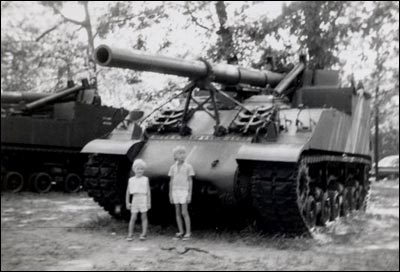
[March 10] My sister, Cheryl, dug up this photograph of us; it was taken in the mid-1960s at Prairie Grove in northwestern Arkansas during one of our vacation trips from Pawnee Rock. We were there because the Civil War battlefield park -- 2,500 soldiers died there on December 7, 1862 -- was a short drive from our grandparents' home near Fayetteville, and once or twice we went for the annual crafts show. I can't speak for Cheryl, but I got a kick out of climbing all over the howitzers, which were placed there as a memorial to veterans of more recent wars. I remember happiness, but I more strongly recall the dusty gray-green paint on the weapons, grabbing the rungs welded onto the guns' backsides, the roughness of the split-log fence nearby, and the smell of hickory nuts and acorns on the ground. About 20 years after this photo was made, I drove to Arkansas to check on a little piece of land I owned near Bentonville and to fish for smallmouth bass. I dropped in on Prairie Grove, which is a little southwest of Fayetteville. For a couple of bucks I bought chicken and grapes and went to meet my memories. The food was good, but the park was unsettling. Nothing was as big as it used to be, and not many kids had climbed on the guns recently; the howitzers' paint had oxidized so much that it rubbed off easily on my hands. You know how it is with youngsters; they see the park around them. Adults see what's around the park and know the history. It was too hard to make myself young and small again, and I just couldn't enjoy the park anymore for what it used to be. Still, I have this photograph and I know that on one sun-dappled afternoon my sister and I had the time of our lives playing on machines built for things we weren't meant to understand. What we see at Ash Creek[March 9] Yesterday's photo of the cottonwoods along Ash Creek stirred thoughts of the prairie primeval in Leon Miller and Ray Randolph. Leon, who grew up on the south side of Pawnee Rock and now lives in Dallas, wrote:
"And by the way, when I was 14 or maybe 15 I decided I was going to make some money trapping for mink and muskrat along the creek. I got about a half dozen traps and set them up and down the creek. I would get up around 5:00 am and trek south across the Inderwiesen land to the creek to run my traps. "To my dismay I never caught a thing except for one Saturday morning I went to check a trap I had set at the spot you describe in your photo and discovered I had finally caught something in my trap -- A SKUNK! I never went back to pick up the trap and it may still be there today." Ray, an ex-patriate Barton Countian writing from Indiana, wrote: "I put on my other glasses -- the special ones that let me see things only I can see -- and I could just make out the shadow of a bicycle by one of the trees and I have to believe that it belongs to that Unruh boy who rides it out there and is always exploring, sometimes until almost dark. "This makes sense to me because that's what I would have done. "Old houses and country roads ... the memories." In my very first Too Long in the Wind post nearly two years ago, I asked for everyone's help in identifying a TV show that mentioned Pawnee Rock and Ash Creek. It was on Channel 2's "Experimental Television" show one Sunday afternoon in the 1960s, and maybe you're another of the few people who saw it. Hello, June[March 8] June McFann, your family wishes you Happy Birthday! A photo I like: No. 77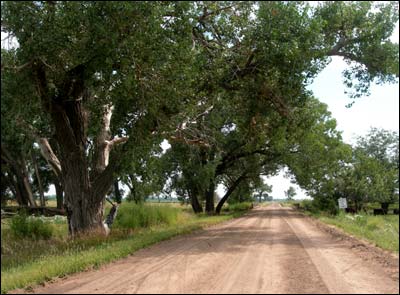
[March 8] This setting is one of my favorite spots near Pawnee Rock. It's a half-mile east and a half-mile south of the southeast corner of town, although anyone from Pawnee Rock is likely to recognize it without thinking. In the normal travel of Pawnee Rockers, Ash Creek is crossed by three roads. The U.S. 56 crossing is noisy and usually dry. The crossing out by the old Keeley place is sedate, with thick grass growing on the banks in the warm months but few trees. This third and final crossing is almost like a park, with the large cottonwoods and deep pools near the bridge. The cottonwoods invite us to park and enjoy the shade and remember the young days when we could disappear into the wilderness of Ash Creek. Flush the Arkansas[March 7] The Colorado River, Lake Powell, and the Grand Canyon were in the news this week because of the "flushing" of the river. An enormous amount of water -- 300,000 gallons a second -- was released from the lake to stir up the sediment in the river and create new sandbars to provide habitat for plants and animals in the canyon. It's a non-Monkey Wrench effort to return the famous river to its condition before the Glen Canyon Dam went up in 1963. Here's an idea: Would the same process work on the Arkansas River?
Coloradoans would throw a hissy fit, but let's say the Corps did open the gates. The river has been dry for so long that there's a good chance that the released water would disappear into the sand and never make it east of Garden City. If a couple of the gates were open for two days, would that be enough to saturate the riverbed so that the spring rains' runoff could flow downstream instead of being absorbed themselves? And if our friends in Colorado would do that for us, would the agricorporations in western Kansas let enough water pass that it would register in Pawnee County? If some water did reach Pawnee Rock, would it be enough return our Arkansas to its clear-water past? Would channel cats live among us again? In a different light
Most of us go to the Rock in the evening, when we've had our hard day and intend to relax in the breeze or see the lights come on up and down the highway. Few of us make it up there in the morning, and that's a shame. The eastern light illuminates everything in a different way, and it opens our minds to views that, because of our habits, we don't get a chance to see. I'm not trying to make a mystical point here, but I do think it's a good idea to go places at times we normally wouldn't, and just look around. We owe ourselves a change of pace from our usual reality. That's why the kids ride in front: Ray Randolph, our man in Indiana, read yesterday's posting about kids on bikes and wrote: "The bike jumping story was going good and all the young 'uns probably know a lot of jumping techniques. But did you have to go and tell 'em about the 'death-ray' button on the handle bars? "Then again, as smart as kids are nowadays, they probably already knew about it. "But us older guys still have some secrets, don't we?" I know them: Susan Unruh Ellis sent IDs for the five high school girls who were posing for a photo in the school gym. They were the 1971 candidates for basketball homecoming queen, she suggests. See the photo in the Gallery. Thanks, Susan. Into the wind: Anyone who ran around the track knows how much fun it is when the wind blows. Cheryl Unruh, in her Emporia Gazette column this week, remembers the wind in Pawnee Rock. Flying on two wheels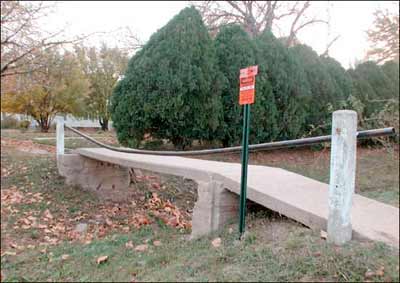
[March 5] I don't know what brought it on, but for the past week or so my brain has been filled with memories of riding a bike into a ditch and back out with a high-flying jump at the end. Most kids in Pawnee Rock during my youth did this at the big ditch on the north side of town, where the concrete bridge carries the sidewalk across between the Bowman and Smith houses. The best bikes for this were undersized Schwinns, modified with banana seats and high-rise handlebars. I had a bike that was far from cool -- a 24-inch, skinny-wheeled women's bike handed down from Mom. Other kids did their swooping and flying with the greatest of ease on their short-wheelbase bikes, but even with mine I launched myself like Evel Knievel. My other favorite jump was in the Rock Street ditch next to the Germans' house (earlier the Wycoffs' house) at the western end of our block of Santa Fe. The sidewalk had settled, creating an unpleasant concrete bump, and it was easier zip into the ditch and sail out into the street. The Germans may not have enjoyed the tire-worn trench and constant bike traffic as much as I did, but they were gracious enough to never mention it or fill the ditch with glass or concrete chunks. When curbs and gutters were installed in the 1970s, that ditch jump was destroyed. And the last time I walked over the big ditch, it didn't look very deep at all. All the good places are gone, I think. Yet when I go out with my sons, it doesn't take them long to find a little hump to fly off of again and again or a sandy spot where they can skid. I suppose fun biking places still exist, but perhaps I've lost the magic that once let me find them. So the boys have fun. Good for them. And they don't even know yet that pushing a little button on their handlebars will fire a death ray. 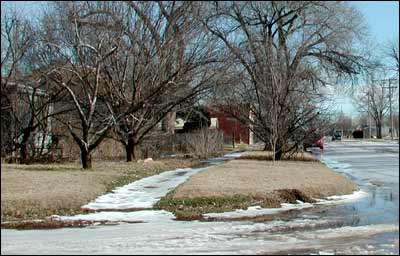
A large elm once shaded this corner at Santa Fe and Rock, and a deep ditch was covered by a sidewalk with a sharp bump. Wealth is where you find it[March 4] The other day one of my sons asked about a printed note on a Coke bottle that said an environmental fee would be charged in some states. I gave them the basics of how some states charge extra for certain products that make up litter. That led to a story of returning pop bottles for money. The boys were amazed that I had spent much of my childhood patrolling the ditches of Pawnee Rock for glass pop bottles and later for aluminum pop and beer cans. I remember those good old days when cans brought something like 16 cents a pound -- basically a penny apiece -- and bottles brought maybe a nickel. Still, that was good money when comic books cost a quarter. It was practically free money for us kids, who had nothing better to do than pick up other people's trash. I had a hard time understanding why people would throw into a ditch something so valuable. Why wouldn't they just toss the bottles and cans into a paper sack and cash them in themselves? Well, now I know that people want to hide evidence from themselves and their spouses. I don't want to see that I've actually drank that many Cokes. It would never do to show up at home with a sack full of beer cans; it's evidence of wasting money, and your spouse would point that out. An officer of the law who pulled you over for speeding might consider it evidence of something else. And you put two guys in a pickup with a sixpack, and macho law requires them to throw the cans and longnecks into the ditch. Those guys might instead try to soothe their troubled souls by tossing the cans into the truck bed, where they wouldn't have to notice when the draft blows the cans out at highway speed. That was the way it worked in the 1970s, and it hasn't changed much. Maybe now it's easier to make money through recycling -- people absorb so many drinks from aluminum cans and toss them away without a thought. There's not much happening in the glass-bottle trade these days. Let's not be too rosy about the pop bottles. Although most kids came by their bottles honestly, some kids stole from their parents or from racks outside gas stations. It was a fine lesson in economics to kids that they could turn little crimes -- littering and theft -- into cash. What made it all work was the patience of clerks at the grocery store, Stella's Cafe, Farmers Grain, and the gas station who paid kids for the bottles and didn't ask questions. I didn't tell my sons that part. Sometimes the full truth has to play second fiddle to idealism, and I rather like the image of the young heroic bottle-picker wandering up and down a wide ditch in search of the five-cent thrill. "Bleeding Kansas" Back December I mentioned that mystery writer Sara Paretsky had a new book set in Kansas. Well, one Kansan -- Tracy Million Simmons -- doesn't think much of the novel. (Thanks to Cheryl Unruh for sending us the link.) March, when the games are good[March 3] There are two things I like about March: college basketball and the Iditarod Trail Sled Dog Race. The Jayhawks, as you know, avenged their loss to K-State by winning Saturday in Lawrence. Soon it'll be time for the conference tournament and then the NCAA games. I imagine I'll end up frustrated by Kansas' eventual loss, but hope survives.
The toughness of mushing to Nome aside, the Iditarod spawns as many office pools in Alaska as the NCAA basketball games do. The one in our newspaper office is minor -- the winner gets $100 -- but it's a purely Alaska drama that above all celebrates the end of winter. I am sapped from these two active days of being around the dogs and two nights of updating my musher's site, but I'm happy that I got to soak up energy from people who pretty much define "determination." Weather watcher: Ray Randolph wrote: "In 'windy Kansas' a 10 mph wind is hardly a breeze and doesn't count for much unless it's to massage the amber waves of wheat. "Did you have a 'weather rock' in PR, and do you have one up yonder? I've been thinking about getting one here. It would be as accurate as the weather people and more fun." The lamb and the wind
The wind was over 16 mph at midnight and by 11 a.m. there were gusts of 35 mph. The wind was out of the south all day, and it never dropped below 11 mph, according to the gauge at the Great Bend airport. The weather forecasters say that's going to bring rain. That's plausible, the way the barometer fell all day Saturday. All this brings to mind the question of what, in windy Kansas, qualifies as "coming in as a lamb"? Would it have to be a perfectly still day, or would a 10 mph wind still qualify? Noodle dinner is today[March 1] The Lions Club noodle dinner is today, so head to the depot in downtown Pawnee Rock. The meal -- featuring homemade beef and noodles and chicken and noodles -- starts at 11 a.m. and is served until 2 p.m. At 2 p.m., there'll be a drawing for good prizes. A photo I like: No. 76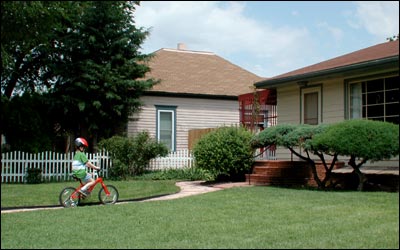
[March 1] This is our son Sam a few years ago, riding his bike up Elgie and Betty Unruh's front walk. I am reminded of my own bicycle years in Pawnee Rock forty years ago. As the generation has changed, so has the scenery. The lawn looks better now than when sister Cheryl and I played on it, and I'm pretty sure I didn't mow it this evenly. The picket fence is still there, but it's shaded by taller and rounder trees. The Tutaks' house is there, but the Tutaks aren't. The shrubs are the ones I grew up with, but they're trimmed differently now. The porch is shorter than it was when I grew up. The sandpaper-rough porch that skinned my knees many times now is just a big step up from the ground. I don't know how Sam will remember this scene in forty years; maybe without this photo he won't. The Unruh family doesn't live there anymore, and he won't be riding his bike up the front walk again. But I will ride mine there forever. |
Sell itAdvertise here to an audience that's already interested in Pawnee Rock: Or tell someone happy birthday. Advertise on PawneeRock.org. |
|
|
 [March 31] Sunday afternoon Kansas University's basketball team played Davidson, the perfect example of an underdog team. Except for the regular Kansas fans, everyone from Los Angeles to Pawnee Rock to Aggieville to Memphis to North Carolina must have been cheering for Davidson.
[March 31] Sunday afternoon Kansas University's basketball team played Davidson, the perfect example of an underdog team. Except for the regular Kansas fans, everyone from Los Angeles to Pawnee Rock to Aggieville to Memphis to North Carolina must have been cheering for Davidson.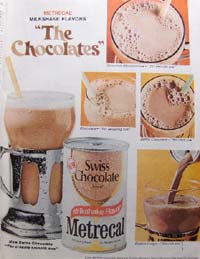
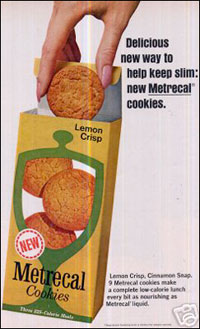
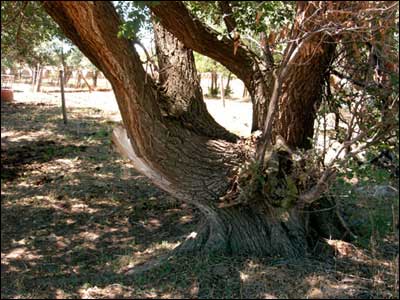
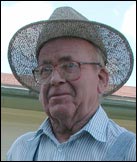 Today Elgie celebrates his 82nd birthday. He is retired from his long employment as a carpenter, bus driver, cemetery sexton, letter carrier, and collector of license tags and bullsnake skins, and his climbing days are long over. He's a bit like this elm -- born of Kansas and tougher than the wind.
Today Elgie celebrates his 82nd birthday. He is retired from his long employment as a carpenter, bus driver, cemetery sexton, letter carrier, and collector of license tags and bullsnake skins, and his climbing days are long over. He's a bit like this elm -- born of Kansas and tougher than the wind.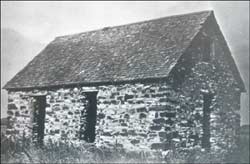 The biography mentions that the Spreiers built a stone house in 1881; perhaps it is this one in our
The biography mentions that the Spreiers built a stone house in 1881; perhaps it is this one in our 
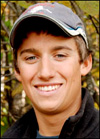 My musher,
My musher, 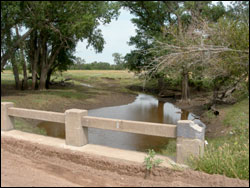 "This too, was one of my favorite spots growing up as I and my buddies launched our makeshift boats (the ones out of corrugated metal and orange crate boxes) and had battles in the creek. However, 60 years ago the trees were not there. How beautiful
a touch they made to an otherwise nondescript scene.
"This too, was one of my favorite spots growing up as I and my buddies launched our makeshift boats (the ones out of corrugated metal and orange crate boxes) and had battles in the creek. However, 60 years ago the trees were not there. How beautiful
a touch they made to an otherwise nondescript scene.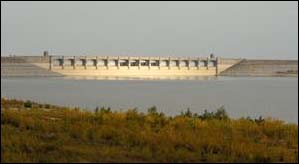 What if the Corps of Engineers opened up the gates on
What if the Corps of Engineers opened up the gates on 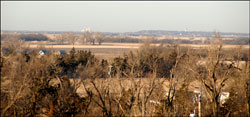 [March 6] Jim Dye loves to take pictures any time of the day, as you all have seen for the past few weeks. What I like about his photo on today's homepage is that it's a good companion to an earlier photo, and it was taken during a different time of day.
[March 6] Jim Dye loves to take pictures any time of the day, as you all have seen for the past few weeks. What I like about his photo on today's homepage is that it's a good companion to an earlier photo, and it was taken during a different time of day. I've spent the past two days engrossed in the Iditarod. Saturday I was in Anchorage, and Sunday I took son Sam out to the lake where the race started for real and we got our musher, Jeff Deeter, on his way. (
I've spent the past two days engrossed in the Iditarod. Saturday I was in Anchorage, and Sunday I took son Sam out to the lake where the race started for real and we got our musher, Jeff Deeter, on his way. (